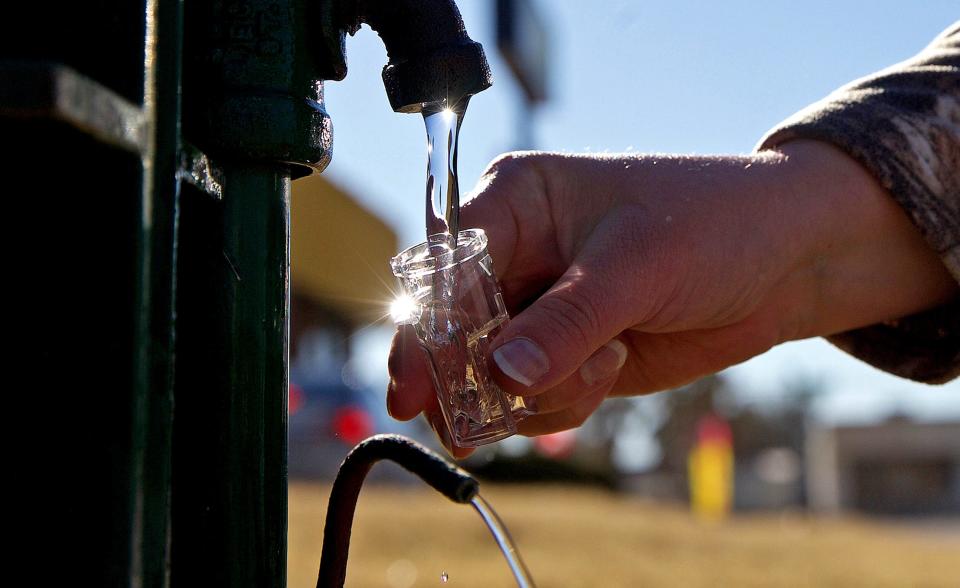The city of San Angelo will soon change the public water supply. Here’s what to know.
The Water Utilities Department will change how it disinfects the public water supply from May 30-June 28, according to a news release.

“This annual preventative maintenance helps properly maintain the water distribution system,” the release stated. “Water users may note a slight change in the smell, taste and appearance of their water that should subside after a couple of weeks.
“This may include a chlorine odor and minor discoloration. The water is still safe for normal usage during this time.”
The chlorine levels and water-quality standards in the distribution system will be monitored daily to be sure all regulatory standards are met.
The department normally uses chloramine, a mix of ammonia and chlorine, to disinfect water.
During this change period, the department will use only chlorine, also known as “free chlorine,” which is a stronger disinfectant than chloramine.
“This is an annual practice common for municipal water systems,” according to the release.
The city’s answers to frequently asked questions
Will I need to do anything differently during this change? No action is necessary. You may drink and use your water normally.
What changes to the water quality will I notice during this period? You may initially notice more of a chlorine taste and smell to your water, especially in showers and sinks. Water also may also be slightly discolored in areas with low flows in water mains. These symptoms should lessen after a couple of weeks.
Is there a way to reduce or remove the chlorine taste and smell during this period? Yes. A carbon filter is effective at removing free chlorine taste and smell, as well as chloramines. If you have an existing carbon filter on your faucet, reverse-osmosis system or cartridge under the sink, these should remove any additional taste and odor during this period. These are available at local retail stores. Some are inexpensive and easy to install.
I have a fish tank. How will it affect my fish? No change or adjustment should be needed. The process you have in place to remove chloramines in the water should also remove free chlorine, but we recommend you check with your equipment supplier.
Will this affect my reverse osmosis system? Some reverse osmosis systems are not designed to work with water that has free chlorine. Owners of RO systems should check their operation manuals or system manufacturers to ensure they will not be adversely affected by the change.
I’ve heard this can affect kidney dialysis machines. Is this true? We recommend you check with your equipment supplier. Different equipment may have different needs or adjustments. The city has contacted local hospitals to alert them of the change.
Will the city do anything to lessen the taste and odors we might experience during this change? Yes, the city will implement procedures to reduce effects as much as possible. However, changes will likely occur and may persist. We will monitor free chlorine levels throughout the system each day to ensure they are at correct levels. You may also see more fire hydrant flushing to keep the chlorinated water moving through water lines with low flow. The Water Utilities Department does not like doing this during drought restrictions, but it will be required in some areas.
Is there a possibility of free chlorine bleaching my clothes? Free chlorine is a stronger disinfectant than chloramine. Even though it may have more of a chlorine smell, the disinfectant residuals in the system will actually be lower than they are currently. We don’t expect problems with bleaching of clothes. If you have brand new clothes that have never been washed, you might wash them first in cold water to let their colors “set” before using a hot water wash.
Will this process improve the quality of my water once it is completed in four weeks? Typically, after a change to free chlorine and then back to chloramine, less disinfectant is needed to maintain residuals in the distribution system. So if you are sensitive to the taste and smell of chloramine, you should see an improvement in water quality after the conversion.
Why is our water system making these changes to our disinfection process? Our water system normally uses ammonia and chlorine as the main means to disinfect water. Mixing these two chemicals forms chloramine, the most common disinfectant used in the United States for water systems that use lakes and rivers as their source.
Occasionally, these systems must return to free chlorine as their disinfectant for a brief time to properly maintain the distribution system. Free chlorine works better than chloramine to control thin biofilms of organics and microbes that can build up in pipelines over time. This is common preventive maintenance used by most water systems that use chloramine as their main disinfectant.
This article originally appeared on San Angelo Standard-Times: City of San Angelo to change water supply
Source Agencies

